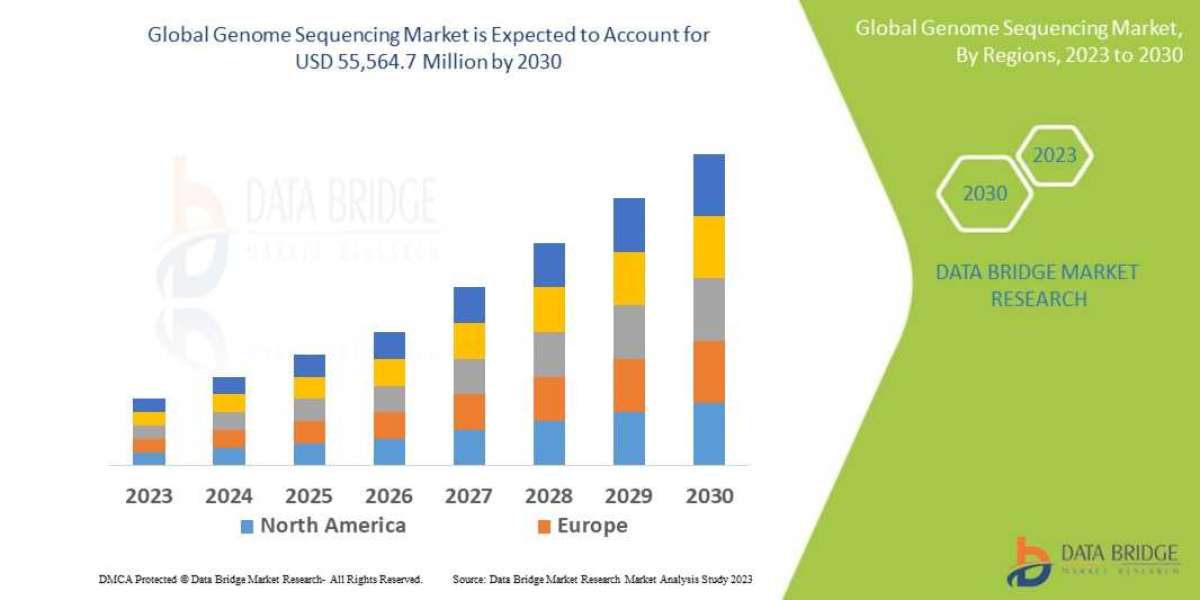"Genome Sequencing Market Size And Forecast by 2031
Data Bridge Market Research analyses that the Global Genome Sequencing Market which was USD 16716.6 Billion in 2022 is expected to reach USD 55564.7 Million by 2030 and is expected to undergo a CAGR of 16.20% during the forecast period of 2022 to 2030
Genome Sequencing Market research report provides a comprehensive analysis of the market. The report aims to provide insights into Genome Sequencing Market trends, growth opportunities, key drivers and challenges, competitive landscape, and other crucial factors that may impact the market in the forecast period (2024-2031).
Get a Sample PDF of Report - https://www.databridgemarketresearch.com/request-a-sample/?dbmr=global-genome-sequencing-market
Which are the top companies operating in the Genome Sequencing Market?
The study report on the Global Genome Sequencing Market offers a comprehensive analysis of the industry, highlighting key trends, market dynamics, and competitive landscape. It profiles prominent organizations operating in the market, examining their successful strategies and market share contributions. This Genome Sequencing Market report provides the information of the Top 10 Companies in Genome Sequencing Market in the market their business strategy, financial situation etc.
**Segments**
- **Technology**: The genome sequencing market can be segmented based on technology into next-generation sequencing (NGS), single-molecule real-time sequencing (SMRT), sequencing by synthesis (SBS), and sequencing by ligation (SBL). Next-generation sequencing holds a significant share in the market due to its high throughput, speed, and cost-effectiveness in decoding DNA sequences.
- **Application**: In terms of application, the market can be classified into diagnostics, drug discovery, precision medicine, agricultural animal research, and others. Diagnostics represent a major segment driven by the increasing adoption of genome sequencing in disease identification and personalized treatment strategies.
- **End-User**: The end-user segmentation of the genome sequencing market includes academic research institutes, pharmaceutical biotechnology companies, hospitals clinics, and others. Academic research institutes are prominent users of sequencing technologies for studying genetic variations and diseases.
**Market Players**
- **Illumina, Inc.**: A key player in the global genome sequencing market, offering a range of sequencing platforms and solutions known for their accuracy and reliability in DNA sequencing applications.
- **Thermo Fisher Scientific, Inc.**: Known for its Ion Torrent semiconductor sequencing technology, Thermo Fisher Scientific is a leading provider of tools and services for genome sequencing and analysis.
- **Pacific Biosciences of California, Inc.**: Specializing in long-read sequencing technologies, Pacific Biosciences caters to the needs of researchers requiring comprehensive genome analysis capabilities.
- **Oxford Nanopore Technologies**: Oxford Nanopore is renowned for its portable and real-time sequencing devices, offering innovative solutions for on-the-go genome sequencing applications.
- **BGI (Beijing Genomics Institute)**: A major player in the genome sequencing market, BGI provides sequencing services and products, contributing significantly to genomic research worldwide.
The global genome sequencing market is witnessing significant growth fueled by technological advancements, increasing applications in various sectors, and rising investments in genomics researchThe genome sequencing market is experiencing a remarkable surge in growth driven by several key factors. One of the primary drivers of the market expansion is the continuous evolution and advancement in sequencing technologies. As technology plays a vital role in enhancing the efficiency and accuracy of genome sequencing, market players are investing heavily in developing next-generation sequencing platforms such as NGS, SMRT, SBS, and SBL. Next-generation sequencing, in particular, has gained significant traction due to its high throughput capabilities, rapid processing speeds, and cost-effective nature, making it a preferred choice for researchers and clinicians alike.
In terms of applications, genome sequencing finds diverse uses across various sectors such as diagnostics, drug discovery, precision medicine, and agricultural animal research. The diagnostics segment holds a significant share in the market, fueled by the increasing adoption of genome sequencing for disease identification and personalized treatment approaches. Moreover, the integration of genomics into drug discovery processes has revolutionized the pharmaceutical industry by enabling targeted therapies and precision medicine solutions. Additionally, the application of genome sequencing in agricultural and animal research has opened up new avenues for enhancing crop productivity, breeding programs, and animal health.
The end-user segmentation of the genome sequencing market includes academic research institutes, pharmaceutical biotechnology companies, hospitals clinics, and others. Academic research institutes play a crucial role in driving the demand for sequencing technologies, as they are at the forefront of genomic studies aimed at understanding genetic variations, disease mechanisms, and potential therapeutic targets. Furthermore, pharmaceutical and biotechnology companies leverage genome sequencing for drug development, biomarker discovery, and personalized medicine approaches, thereby contributing significantly to the market growth.
Leading market players such as Illumina, Inc., Thermo Fisher Scientific, Inc., Pacific Biosciences of California, Inc., Oxford Nanopore Technologies, and BGI (Beijing Genomics Institute) are spearheading the innovation and development efforts in the genome sequencing landscape. These companies offer a diverse range of sequencing platforms, solutions, and services tailored to meet the evolving needs of**Market Players**
- Abbott (U.S.)
- bioMérieux (France)
- B.D. (U.S.)
- Danaher (U.S.)
- Thermo Fisher Scientific Inc., (U.S.)
- Siemens (Germany)
- Agilent Technologies, Inc, (U.S.)
- Merck KGaA (Germany)
- Illumina Inc. (U.S.)
- QIAGEN (Germany)
- Bio-Rad Laboratories, Inc. (U.S.)
- Eurofins Scientific (Luxembourg)
- Danaher (U.S.)
- Oxford Nanopore Technologies plc (U.K.)
- F. Hoffmann-La Roche Ltd (Switzerland)
- BGI (U.S.)
- General Electric (U.S.)
- LI-COR, Inc (U.S.)
- Siemens (U.S.)
- PerkinElmer, Inc. (U.S.)
- Macrogen, Inc (South Korea)
- BIONEER CORPORATION (South Korea)
The global genome sequencing market is rapidly evolving with significant growth prospects, driven by technological advancements, expanding applications across multiple sectors, and increasing investments in genomics research. The market is witnessing a surge in demand for next-generation sequencing technologies such as NGS, SMRT, SBS, and SBL, which offer high throughput, speed, and cost-effectiveness in decoding DNA sequences. This trend is reshaping the landscape of genome sequencing by enhancing efficiency and accuracy, thereby attracting researchers and clinicians towards these
Explore Further Details about This Research Genome Sequencing Market Report https://www.databridgemarketresearch.com/reports/global-genome-sequencing-market
Regional Analysis For Genome Sequencing Market
North America (the United States, Canada, and Mexico)
Europe (Germany, France, UK, Russia, and Italy)
Asia-Pacific (China, Japan, Korea, India, and Southeast Asia)
South America (Brazil, Argentina, Colombia, etc.)
The Middle East and Africa (Saudi Arabia, UAE, Egypt, Nigeria, and South Africa)
Why B2B Companies Worldwide Rely on us to Grow and Sustain Revenues:
- Get a clear understanding of the Genome Sequencing Market, how it operates, and the various stages of the value chain.
- Understand the current market situation and future growth potential of the Genome Sequencing Market throughout the forecast period.
- Strategize marketing, market-entry, market expansion, and other business plans by understanding factors influencing growth in the market and purchase decisions of buyers.
- Understand your competitors’ business structures, strategies, and prospects, and respond accordingly.
- Make more informed business decisions with the help of insightful primary and secondary research sources.
This report provides Global Genome Sequencing Market :
- An in-depth overview of the global market for
- Genome Sequencing Market Assessment of the global industry trends, historical data from 2015, projections for the coming years, and anticipation of compound annual growth rates (CAGRs) by the end of the forecast period.
- Discoveries of new market prospects and targeted marketing methodologies for Global Genome Sequencing Market
- Discussion of RD, and the demand for new products launches and applications.
- Wide-ranging company profiles of leading participants in the industry.
- The composition of the market, in terms of dynamic molecule types and targets, underlining the major industry resources and players.
- The growth in patient epidemiology and market revenue for the market globally and across the key players and Genome Sequencing Market segments.
- Study the market in terms of generic and premium product revenue.
- Determine commercial opportunities in the market sales scenario by analyzing trends in authorizing and co-development deals.
Understanding market trends and industry insights at a regional level is essential for effective decision-making. Our reports are available in multiple regional languages to cater to diverse audiences. These localized reports provide in-depth analyses tailored to specific regions, ensuring businesses and stakeholders can access accurate and relevant information. By offering insights in local languages, we aim to bridge communication gaps and empower regional markets with the knowledge they need to grow and thrive. Explore our reports in your preferred language for a more personalized understanding of industry dynamics.
Japanese : https://www.databridgemarketresearch.com/jp/reports/global-genome-sequencing-market
Chinese : https://www.databridgemarketresearch.com/zh/reports/global-genome-sequencing-market
Arabic : https://www.databridgemarketresearch.com/ar/reports/global-genome-sequencing-market
Portuguese : https://www.databridgemarketresearch.com/pt/reports/global-genome-sequencing-market
German : https://www.databridgemarketresearch.com/de/reports/global-genome-sequencing-market
French : https://www.databridgemarketresearch.com/fr/reports/global-genome-sequencing-market
Spanish : https://www.databridgemarketresearch.com/es/reports/global-genome-sequencing-market
Korean : https://www.databridgemarketresearch.com/ko/reports/global-genome-sequencing-market
Russian : https://www.databridgemarketresearch.com/ru/reports/global-genome-sequencing-market
Data Bridge Market Research:
Contact Us:
Data Bridge Market Research
US: +1 614 591 3140
UK: +44 845 154 9652
APAC: +653 1251 1404














